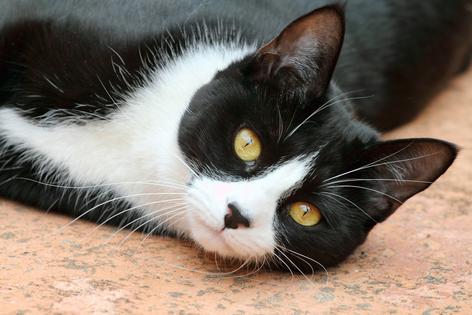My Pet World: Helping Kasey feel safe — Building trust with a nervous cat
Dear Cathy,
We got Kasey when he was two, many years ago, from my daughter who passed away. He’s now a healthy 14-year-old tuxedo. Kasey is afraid of me and avoids all men. He connects with my wife on a limited basis, sometimes sitting near her or briefly on her lap, but only in the evening, near her lounge chair, and only if I’m not in the room. He will occasionally settle in the room if my wife’s female friends visit.
He seems like a nervous cat. I’ve thought about tranquilizers, but he only eats one thing – a crunchy kibble from a popular manufacturer. He won’t touch treats or any other food.
Pheromones haven’t helped. He enjoys some catnip but loves chewing soft plastic – shower curtains, bags, anything he can find. The only sign of him playing is when we find his toys scattered around in the morning.
Right now, he’s even avoiding my wife because she was away for four days. Any suggestions on how we can help him be more engaging?
— Anthony, Northport, New York
Dear Anthony,
Kasey’s behavior reflects a combination of long-standing fear, sensitivity to change, and selective social interaction – something not uncommon in older cats, especially those with a complicated history. At 14 years old, and after so many years of living this way, it’s unlikely he’ll transform into a fully affectionate lap cat, but that doesn’t mean you can’t help him feel more secure and gradually build trust.
The first step is to respect his boundaries. Since he’s naturally skittish around men and only connects with your wife on a limited basis, it’s important to let him approach you on his own terms. Any attempts to force interaction may only heighten his anxiety. He’s also adjusting after your wife’s recent trip, so giving him time to reestablish his routine will help him settle. Cats are very routine-oriented, and disruptions, even brief ones, can feel like major events to them.
Because Kasey doesn’t accept treats, you’ll need to find other ways to create positive associations with your presence. Sitting quietly in the same room without trying to interact allows him to get used to you. Since he plays with his toys overnight when no one is watching, you might also experiment with tossing a toy near him or using a wand toy from a distance. This can gradually build a sense of fun and safety around you without any pressure.
Your wife can continue using his predictable routines to her advantage, like those brief evening interactions near the lounge chair. If you sit nearby during these familiar moments without engaging, Kasey may slowly grow more comfortable with your presence. Over time, these small exposures can build trust.
Since he does enjoy some form of play when no one is around, adding puzzle feeders or toys that mimic hunting behaviors may provide him with more enrichment when you are not around. Even something as simple as a motorized mouse or a toy that dispenses his kibble could offer stimulation while reinforcing his environment as safe and rewarding.
You might also try some very gentle desensitization techniques. Sit nearby while your wife interacts with him. Speak softly, read aloud, or place a blanket or towel that carries your scent in his favorite resting spots. Over time, even these small associations can help him feel less threatened by your presence.
Because tranquilizers aren’t an option, and you’ve already tried pheromones with little success, your best approach for easing his anxiety may be environmental. Giving him vertical space, like tall cat trees, window perches, or extra hiding spots helps nervous cats feel secure.
Kasey may never be the social butterfly you hope for, but older cats, especially those with anxiety or trauma in their past, can change, slowly. I have seen some truly wonderful progress in similar cases when pet parents stay patient, consistent, and committed to earning their cat’s trust. In Kasey’s world, slow and steady is the best path forward.
Dear Cathy,
In your letter to Fred in Freeport, you forgot to mention the North Shore Animal League (in our area) was a place to adopt. It’s a great shelter. We got our border collie there.
— Fred, Westbury, New York
Dear Fred,
North Shore Animal League in Port Washington, New York, is a wonderful place to adopt. They’ve helped so many animals over the years, and I’m glad you found your border collie there.
No matter where people adopt from — large organizations like North Shore or smaller local rescues — the most important thing is giving a pet a loving home. And you did, thank you!
_____
_____
========
(Cathy M. Rosenthal is a longtime animal advocate, author, columnist and pet expert who has more than 25 years in the animal welfare field. Send your pet questions, stories and tips to cathy@petpundit.com. Please include your name, city, and state. You can follow her @cathymrosenthal.)
©2025 Tribune Content Agency, LLC.
(c) 2025 DISTRIBUTED BY TRIBUNE MEDIA SERVICES, INC.












Comments